Innovation has always been the driver of progress. From the wheel to the smartphone, great inventions began as simple ideas that solved real problems. Today, invention ideas are more important than ever because they inspire students, entrepreneurs, and everyday people to create solutions that improve life. Whether you want to tackle everyday problems, launch a business, or dream up futuristic technology, invention ideas provide a foundation for creative breakthroughs.
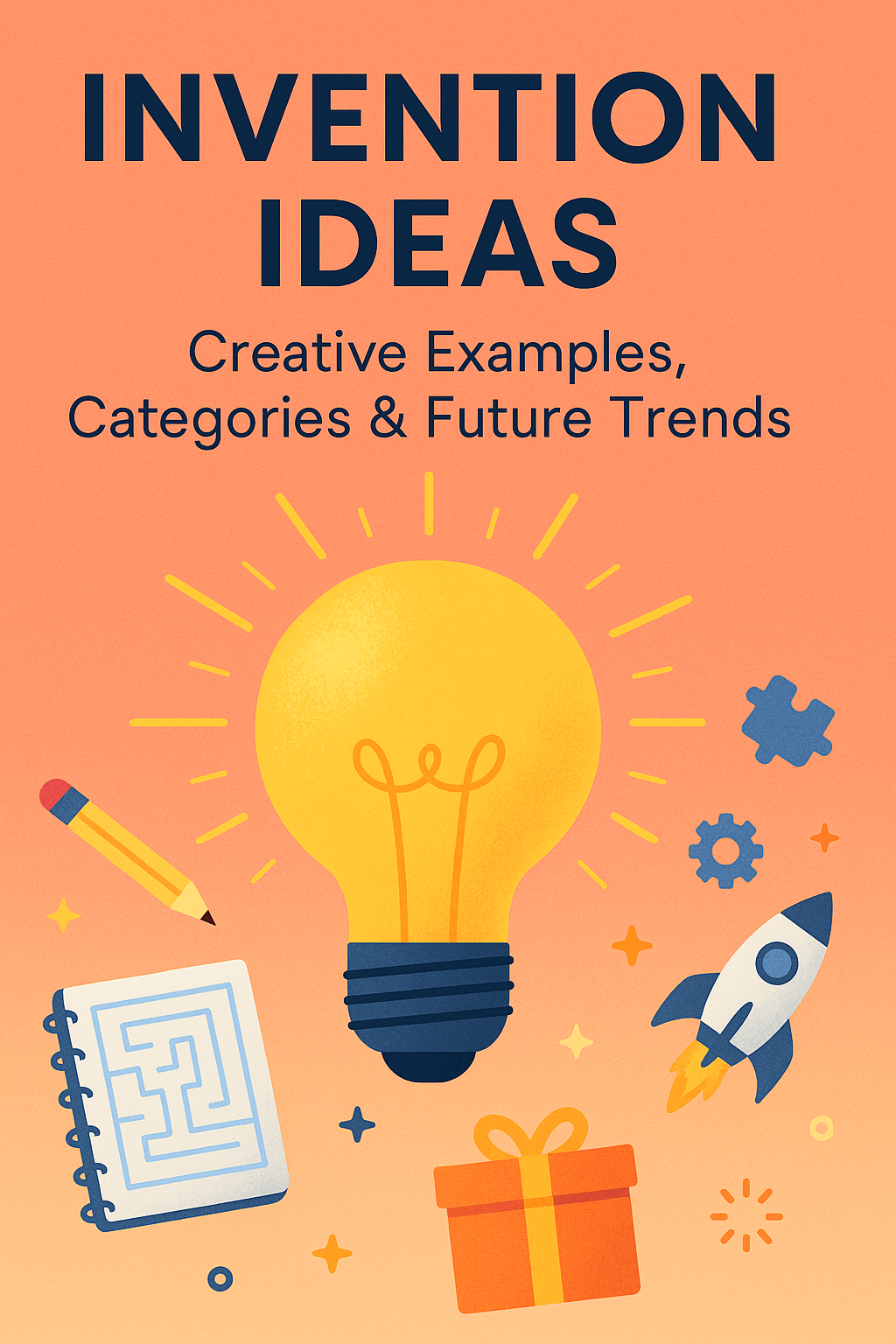
Introduction To Invention Ideas
Invention ideas matter because they spark innovation and fuel progress in society. They are not limited to laboratories or big companies. In fact, many life-changing inventions began as simple thoughts from ordinary people. An invention can be any product, device, or process that solves a problem or makes life easier. For instance, a better way to organize cords may seem small, but such a solution can be just as valuable as a new smartphone app.
Brainstorming matters because it allows people to connect problems with creative solutions. Students learn problem-solving skills through inventive school projects, while entrepreneurs develop profitable ventures by identifying unmet needs. History has shown that the most creative solutions often come from observing what frustrates us daily. Everyday problems like food going stale, tangled headphones, or inconvenient travel gear can all spark new ideas that lead to meaningful change.
The History Of Invention Ideas
Looking at the past shows how invention ideas shaped human civilization. Ancient innovations such as the wheel, the compass, and paper solved immediate survival and communication challenges, laying the foundation for trade, exploration, and cultural development. These examples prove that the earliest inventors were not necessarily engineers but ordinary people finding clever ways to meet essential needs.
In modern history, breakthroughs like the light bulb, airplane, and telephone came from persistence. At first, many dismissed them as unrealistic. Yet, with determination, these inventions revolutionized daily life. From Thomas Edison refining the light bulb to Alexander Graham Bell perfecting the telephone, these pioneers demonstrate that invention is a process of trial, failure, and improvement. Today, smartphones, Wi-Fi, and medical imaging are proof that small sparks of inspiration can evolve into life-changing technologies.
Categories Of Invention Ideas
Invention ideas come in many forms, each inspired by different needs, industries, and levels of creativity. They can be grouped into broad categories that reflect both everyday life and the future of technology. Some inventions focus on practicality like household gadgets, educational tools, or health-related devices that simplify routines and improve quality of life. Others push boundaries in fields such as sustainability, where eco-friendly designs tackle global issues like pollution and energy consumption. The rise of smart technology and automation has also created new categories, including digital assistants, robotics, and connected home systems. Even artistic and recreational inventions play an important role, merging creativity with function. By exploring these diverse categories, inventors can identify where their passions and problem-solving skills align, leading to ideas that are both meaningful and marketable.
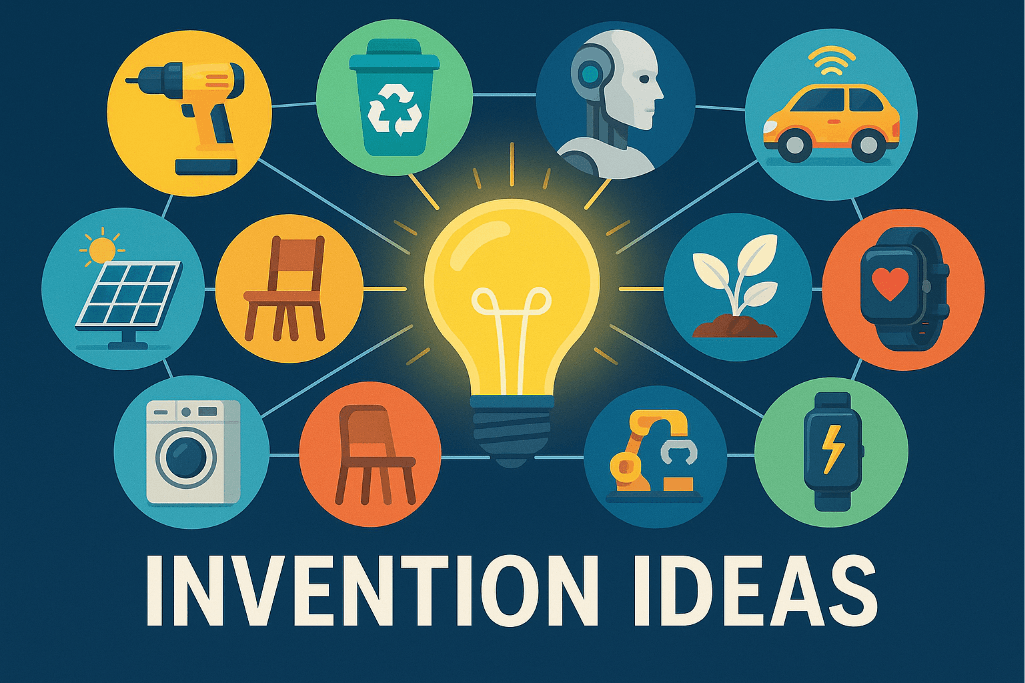
Household And Everyday Life Inventions
Household inventions make life more convenient. Examples include spill-proof mugs, collapsible storage, and self-cleaning kitchen tools. These types of invention ideas are usually low-cost, easy to prototype, and highly marketable because they address common frustrations.
Technology And Sustainability
Technology invention ideas include apps, software, and gadgets that enhance digital life. From AI-powered assistants to secure communication tools, technology continues to reshape modern living. On the other hand, eco-friendly inventions target sustainability. Products like biodegradable packaging or water-saving shower devices not only improve life but also help protect the planet. Combining tech with sustainability, such as smart home energy systems, is a rapidly growing trend.
Health And Wellness
Health-related inventions are becoming more important as people focus on fitness and well-being. Examples include portable health monitors, fitness wearables, and mental health apps. These innovations make healthcare more accessible and encourage proactive wellness.
Education And Business
Students and entrepreneurs benefit from invention ideas designed for their goals. Solar-powered school projects, recycling initiatives, and innovative learning tools encourage creativity in education. Meanwhile, entrepreneurs often look for small gadgets or productivity tools that can generate income. These categories prove that invention is not only about big breakthroughs but also about finding ways to improve daily life.
Simple Invention Ideas Anyone Can Try
Not every great invention requires a laboratory or a large budget. Sometimes the most effective ideas are the simplest. Simple invention ideas often begin at home, using materials already on hand to solve everyday problems. You might create a multifunctional desk organizer, a self-watering plant system, or even a hands-free phone holder from recycled parts. What makes these ideas powerful isn’t their complexity but their practicality and accessibility. Anyone, from a student to a hobbyist, can turn small frustrations into creative projects with a bit of curiosity and resourcefulness. These inventions can be made with basic tools like glue guns, cardboard, and spare electronics, yet they teach valuable lessons in design and problem-solving. Many successful inventors started this way testing, tweaking, and learning through trial and error until their ideas evolved into something useful and inspiring.
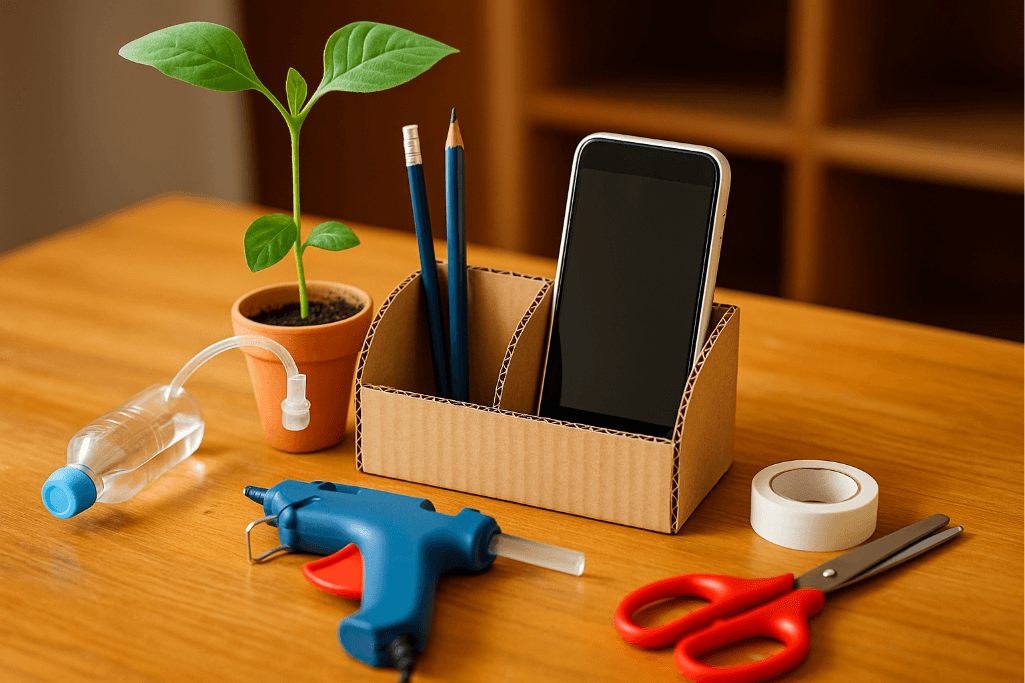
DIY And School Projects
Some of the most fun invention ideas involve DIY creativity. Turning plastic bottles into planters or reusing waste materials to build organizers are easy ways to explore innovation. Students can experiment with homemade air filters or solar-powered lamps for science fairs. These projects not only showcase imagination but also encourage sustainability.
Everyday Problem Solvers
Daily frustrations are excellent sources of invention ideas. Whether it’s a better phone stand, a lightweight folding chair, or a hands-free bag, these inventions address practical needs. By paying attention to small inconveniences, anyone can come up with ideas that improve daily routines. Many profitable inventions started with the question: “How can this be easier?”
Advanced Invention Ideas For Innovators
As technology evolves, the world is entering an age where innovation defines progress. Advanced invention ideas are no longer limited to large corporations or research labs. They’re emerging from independent inventors, students, and small startups with big visions. These ideas often merge fields like artificial intelligence, robotics, and green energy, pushing the limits of what’s possible in everyday life. Innovators are using new tools such as 3D printing, open-source hardware, and affordable sensors to build prototypes that were once impossible to create without major funding. Whether developing smart home devices, sustainable materials, or cutting-edge medical technologies, today’s inventors have access to more opportunities than ever to make a real global impact. The key lies in curiosity, persistence, and a willingness to explore bold concepts that blend creativity with practicality.
Smart Home, IoT, And Robotics
Smart home invention ideas include energy-efficient thermostats, automated lighting, and AI-powered cleaning robots. Combined with robotics, these technologies create convenience and efficiency. In the future, automated delivery drones and connected IoT devices could change how people interact with their homes and communities.

Medical And Assistive Technologies
Assistive technology invention ideas focus on independence and accessibility. From robotic prosthetics to portable health monitors, these innovations make daily life easier for people with medical conditions. They also highlight how invention ideas can directly improve quality of life.
Green Energy And Sustainability Projects
The future of energy depends on innovation. Advanced solar panels, wind turbines, and innovative battery systems are just some of the ways green energy invention ideas are tackling climate change. These projects often attract funding and global interest, proving that eco-friendly innovation is both impactful and profitable.
How To Generate Your Own Invention Ideas
Coming up with original invention ideas doesn’t require genius-level creativity. It requires curiosity, observation, and the courage to think differently. Every great invention starts with a problem waiting to be solved, whether it’s something as small as improving a daily routine or as big as reducing global waste. The best inventors train themselves to notice inefficiencies and ask, “How could this be better?” By combining brainstorming techniques, mind mapping, and creative experimentation, you can transform ordinary thoughts into extraordinary solutions. Inspiration can come from anywhere, conversations, nature, technology, or even your own frustrations. Keep a journal of ideas, sketch concepts when inspiration strikes, and don’t dismiss ideas that seem strange or impossible. Often, it’s those unusual thoughts that lead to the most innovative breakthroughs.
Brainstorming And Inspiration
Start by identifying everyday problems. For example, tangled cables or food waste can inspire new products. Brainstorming works best when you allow creative freedom without judgment. Many inventors use journaling or group discussions to spark unique solutions.
Combining And Visualizing Ideas
Another effective method is merging existing products into hybrids, such as a backpack with solar panels that charges devices. Visual tools like sketches and mind maps help structure ideas and reveal possibilities. By combining creativity with structure, inventors transform vague thoughts into actionable concepts.
Turning Invention Ideas Into Reality
Turning invention ideas into reality is where creativity meets action. Many people stop at the idea stage, but the true mark of an inventor lies in execution. Once you’ve identified a promising concept, it’s time to research, prototype, and test. Start small and even a rough model made from cardboard or 3D-printed parts can help you visualize your idea. Use market research to understand your audience and refine your design through feedback from real users. Today’s tools make it easier than ever to bring concepts to life: 3D printing, open-source electronics, and affordable design software allow inventors to test ideas at home. Don’t fear failure; every prototype that doesn’t work teaches you something valuable. By refining and improving, your invention can evolve from a sketch on paper into a product that solves real-world problems and even reaches the marketplace.
Research And Validation
Before investing time and money, it’s crucial to verify originality. Conducting market research and checking patent databases prevents wasted effort and identifies opportunities.
Prototyping And Feedback
Prototypes bring ideas to life. Tools such as 3D printing allow inventors to create early models quickly and affordably. Sharing prototypes with test users provides feedback, which helps refine designs and ensures the product meets real-world needs.
Cost-Effective Tools
Affordable resources like online CAD software, maker spaces, and DIY electronics kits have made innovation more accessible than ever. These tools empower everyday people to bring invention ideas into reality.
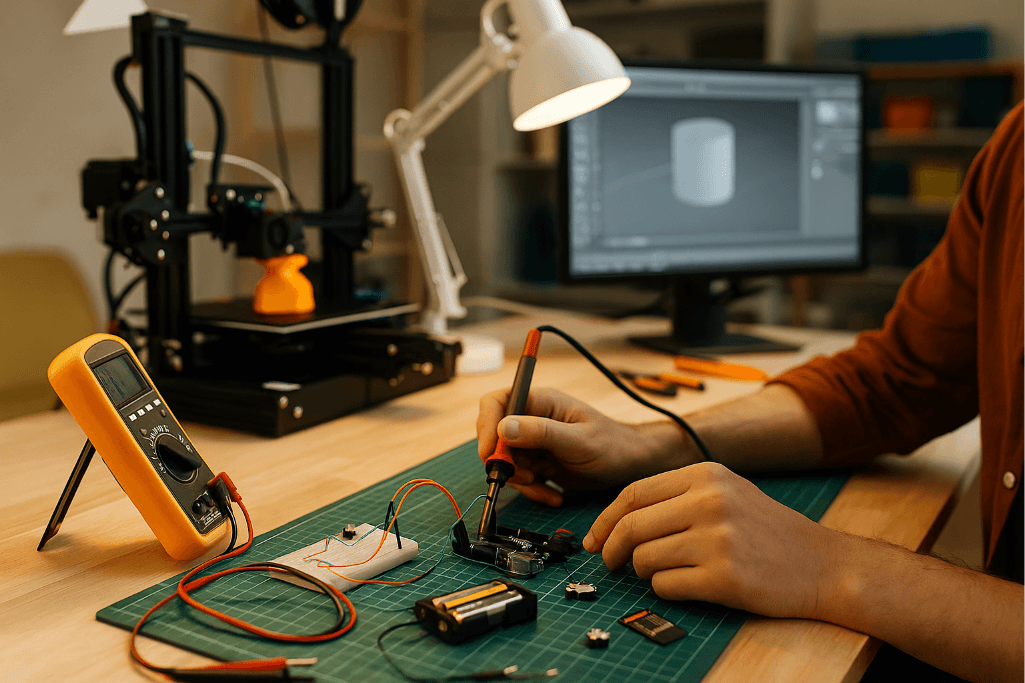
Protecting And Profiting From Invention Ideas
Once you’ve transformed your idea into a working prototype, the next step is protecting it and exploring ways to profit. Safeguarding your invention ensures that your time, creativity, and investment are secure. Applying for patents gives you exclusive rights to produce and sell your creation, while trademarks protect your brand identity. For inventors on a budget, even documenting your design process and filing a provisional patent application can provide initial protection. When it comes to profit, there are several paths: you can license your invention to established companies for royalties, partner with manufacturers, or launch a crowdfunding campaign to raise funds and attract early customers. Some inventors also share open-source inventions to build community support and gain recognition. The key is understanding which route fits your goals. Whether you want steady income, brand visibility, or to see your idea make a difference in the world.
Patents, Trademarks, And Open Access
Patents and trademarks provide legal protection. However, not all inventors seek exclusivity. Some prefer releasing open-source inventions, which can spread faster and bring recognition without legal costs.
Licensing And Crowdfunding
For those who want financial reward without building a business, licensing is a strong option. Companies often pay royalties for licensed inventions. Alternatively, platforms like Kickstarter allow inventors to launch products directly through crowdfunding campaigns.
Famous Invention Ideas That Almost Didn’t Happen
Some of today’s most famous inventions nearly failed. The telephone was initially doubted, yet it redefined communication. Post-It Notes began as a failed adhesive experiment before becoming an office staple. Similarly, 3D printing started as a niche idea but now powers industries from healthcare to construction. These stories prove that persistence is often the key to invention success.
Future Trends In Invention Ideas
The future of invention ideas is moving toward a world driven by intelligence, sustainability, and human-centered design. As technology becomes more accessible, even small inventors can participate in shaping global innovation. The next wave of breakthroughs will come from combining artificial intelligence, green energy, and biotechnology to solve massive challenges like climate change, healthcare, and resource scarcity. Imagine AI-powered systems that predict medical conditions before they happen, or renewable energy inventions that make clean power available to every household. Space exploration is also becoming a frontier for independent creators, with opportunities to design tools, materials, and life-support systems for missions beyond Earth. These advancements aren’t distant dreams they’re active areas of research and invention today. The future belongs to innovators who can blend technology with compassion, building a smarter, cleaner, and more sustainable world through their ideas.
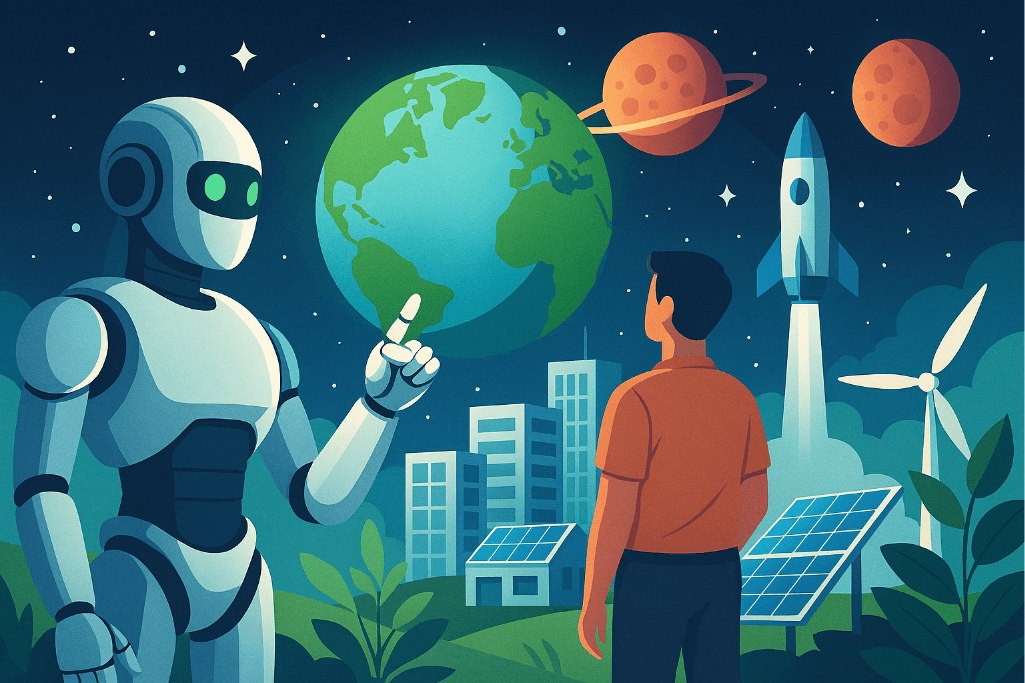
- AI and Automation: Personalized education platforms and adaptive smart assistants will continue to grow.
- Space Exploration: Sustainable Mars habitats and radiation shields may soon become reality.
- Renewable Energy and Biotech: Next-generation solar panels, lab-grown food, and genetic editing tools show how invention ideas could change the world.
Final Thoughts
Invention ideas connect imagination with action. Whether simple or advanced, they shape industries, solve problems, and inspire progress. By brainstorming, experimenting, and acting on ideas, anyone can join the legacy of inventors who made the world better. The future is wide open for those ready to innovate.
FAQs
What Are The Easiest Inventions To Start With?
Easy invention ideas include DIY projects with household items, such as recycling-based gadgets or simple organizers.
How Do I Protect My Invention Idea Legally?
Protection comes through patents and trademarks. Consulting a professional ensures your rights are secure.
Can Students Or Kids Create Real Inventions?
Yes. Students can build science fair projects or eco-friendly gadgets that make a real impact.
What Are Some Invention Ideas That Can Make Money Fast?
Profitable invention ideas include small household gadgets or eco-friendly products launched through crowdfunding.
How Do I Know If My Invention Idea Is Original?
Researching patents and product databases helps confirm originality. Conducting a patent search ensures your idea is unique.
Also Read: Famous Scientists Who Changed The World: Their Discoveries And Impact
